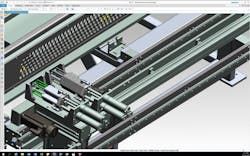How Burr Oak Tool Uses a Digital Twin for Virtual Commissioning
This article was originally posted on April 23, 2019.
One of the more practical applications of the digital twin for manufacturers is in virtual commissioning. In this process, engineers have an exact, virtual model of a machine or system—built from that machine or system’s own data—on which they can test and verify specific functions for real world commissioning purposes.
At the 2019 Manufacturing in America event, Colm Gavin of Siemens, along with Eric Lund and Adam Broadwater from Burr Oak Tool, a manufacturer of machining tools and equipment based in Sturgis, Mich., explained how Burr Oak Tool has been using digital twins to virtually commission its equipment used in the manufacturing of HVAC units.
In the presentation, Lund showed how two of Burr Oak’s tooling heads are used to assemble heat exchanger coils. An XY gantry moves the tools in a complex sequence of operations to seal the coils. The tools’ six cylinders move into and out of a matrix of holes in the coil in this sealing operation.
“Motion coordination is critical in this process to not damage to coils,” said Gavin.
Lund explained that, by bringing the tools’ Solidworks CAD files into Siemens PLM’s NX Mechatronics Concept Designer, Siemens NX could then animate the static 3D model of the machine from Solidworks to see how it operates using real world PLC data.
This 3D model—or digital twin—can be used to debug the machine as part of the commissioning process because it uses actual PLC code that controls the machine and its tools. Gavin said the PLC code is used to “trigger the animation.”
The Simatic S7-1500 PLCs used by Burr Oak on its machines can be simulated with Siemens PLCSim Advanced software (the virtual controller of the Simatic S7-1500 PLC). Siemens uses a high-speed communications link to connect the S7-1500 and I/O scans with Siemens NX simulation and design software. Gavin said this high-speed communication capability is unique in the industry.
According to Gavin, the Application Programming Interface in PLCSim Advanced allows for software in the loop, high-speed, synchronous communication of the I/O from the virtual PLC to the NX modeling software in less than 5ms.“Plus,there are no changes to the PLC code required when switching from the virtual PLC to the real PLC at a later time,” he said. “This means that PLCSim Advanced allows you to test the safety logic.”
Having this link between “real world automation systems and the virtual world means the digital twin is controlled by automation, not by a CAD program,” said Gavin. “This makes the animated model real, not an approximate simulation.”
Broadwater said that, to make the model an exact match of the real world machine, the naming convention used for all the different objects (tag names) in the virtual machine was the same as the one used in the PLC code. “By keeping the naming convention in place between the real and virtual worlds, we’re able to import I/O data from PLCSim Advanced to trigger animations in the model, export that data to an Excel file from TIA Portal v15, and then import all of that into NX’s Mechatronics Concept Designer,” he said. “From there, we can pull data from the Mechatronics Concept Designer to verify the PLC program.”
An important part of this project for Burr Oak was being able to “bring in the part data involved in this complex sequence to verify that our software was accurately replicating that part data info,” said Broadwater. “By exporting the NX data into Excel, we could see that we replicated the part correctly and verified that each tool had gone through the proper sequence and done what we needed it to do. Essentially, we can verify the sequence of operations to prove out the model before building the machine.”
“Having this ability to test the logic before the machine is built has increased communications between the design and manufacturing teams at Burr Oak, improved our products, and avoided tooling damage in the real world,” said Lund. “It also allows us to virtually test future design enhancements and create faster software iterations of new designs.”
Lund noted that Burr Oak initially looked at adding this digital twin capability as part of an objective to reduce the time to market for its equipment and give its engineers time to develop the programs they’ll use on the machine without having to wait for the full machine to be produced. Since its adoption of the Siemens software in coordination with the Solidworks CAD software, Burr Oak has been able to reduce its machine building process by four to six weeks.
And with the high operator turnover experienced by many of Burr Oak’s customers, the company has also discovered that it can use these virtual models to train new operators on how to use Burr Oak machines without occupying machine time on the floor, said Lund.
About the Author
David Greenfield, editor in chief
Editor in Chief

Leaders relevant to this article:
